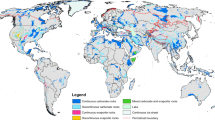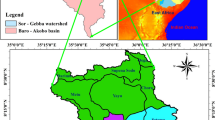Abstract
Tunisian Chott’s region is one of the most productive artesian basins in Tunisia. It is located in the southwestern part of the country, and its groundwater resources are developed for water supply and irrigation. The chemical composition of the water is strongly influenced by the interaction with the basinal sediments and by hydrologic characteristics such as the flow pattern and time of residence. The system is composed of an upper unconfined “Plio-Quaternary” aquifer with a varying thickness of 20–200 m, an intermediate confined/unconfined “Complex Terminal” aquifer about 100 m in thickness and a deeper “Continental Intercalaire” aquifer about 150 m in thickness separated by thick clay and marl layers. The dissolution of evaporites and carbonates explains part of the contained Na+, Ca2+, Mg2+, K+, SO 2−4 and Cl-, but other processes, such carbonate precipitation, also contributes to the water composition. The stable isotope composition of waters establishes that the deep groundwater (depleted as compared to present corresponding local rainfall) is ancient water recharged probably during the late Pleistocene and the early Holocene periods. The relatively recent water in the Plio-Quaternary aquifer is composed of mixed waters resulting presumably from upward leakage from the deeper groundwater.









Similar content being viewed by others
References
Appelo CAJ, Postma D (1994) Geochemistry, groundwater and pollution. 2nd edn. A.A. Balkema, Rotterdam
Castany G (1982) Bassin sédimentaire du Sahara septentrional (Algérie-Tunisie)—Aquifères du Continental intercalaire et du Complexe Terminal. Bulletin Bureau Recherches Géologiques Minières (BRGM). Série 2.3. 127–147
Celle H, Zouari K, Travi Y, Daoud A (2001) Caractérisation isotopique des pluies en Tunisie. Essai de typologie dans la région de Sfax. CR Acad Sci Paris 6:625–631
Coleman ML, Shepherd TJ, Durham JJ, Rouse JE, Moore GR (1982) Reduction of water with zinc for hydrogen isotope analysis. Anal Chem 54:993–995
Coque R (1962) La Tunisie présaharienne: étude géomorphologique. Armond Colin, Paris
Craig H (1961) Isotopic variations in meteoric water. Science 133:1702–1703
Edmunds WM, Shand P, Guendouz AH, Moula A, Mamou A, Zouari K (1997) Recharge characteristics and groundwater quality of the grand Erg oriental basin. Tech. Rep. Wd/97/46R, Vienna
Edmunds WM, Guendouz AH, Mamou A, Moula A, Shand P, Zouari K (2003) Groundwater evolution in the Continental Intercalaire aquifer of southern Algeria and Tunisia: trace element and isotopic indicators. Appl Geochem 18:805–822
Epstein S, Mayeda TK (1953) Variations of 18O content of waters from natural sources. Geochim Cosmochim Acta 4:213–224
El Guedri M (1999) Assessment of scaling and corrosion problems in the Kebili geothermal field, Tunisia. Report 1 in: Geothermal Training in Iceland 1999, UNU G.T.P. Iceland, pp 1–40
Gasse F (2000) Hydrological changes in the African tropics since the Last Glacial Maximum. Quat Sci Rev 19:189–211
Guendouz A, Moulla AS, Edmunds WM, Zouari K, Shand P, Mamou A (2003) Hydrogeochemical and isotopic evolution of water in the Complex Terminal aquifer in the Algerian Sahara. J Hydrol 11:483–495
Hrnchiri M, Slim-S’Himi N (2006) Silification of sulphate evaporites and their carbonate replacements in Eocene marine sediments, Tunisia: two diagenic trends. Sedimentology, pp 1–25
Kamel S, Dassi L, Zouari K, Abidi B (2005) Geochemical and isotopic investigation of the aquifer system in the Djerid-Nefzaoua basin, southern Tunisia. Environ Geol 49:159–170
Kamel S, Dassi L, Zouari K (2006) Approche hydrogéologique et hydrochimique des échanges hydrodynamiques entre aquifers profon et superficial du basin du Djérid, Tunisie (Hydrogeological and hydrochemical approach of hydrodynamic exchanges between deep and shallow aquifers in the Djerid basin Tunisia). IAHS 51:713–730
Kharaka YK, Carothers WW (1968) Oxygen and hydrogen isotope geochemistry of deep basin brines. In: Fritz JCF (ed) Handbook of environmental isotope geochemistry, 2. The terrestrial environment B, Elsevier, Amsterdam, pp 305–353
Maley J (2000) Last glacial maximum lacustrine and fluviatile formation in the Tibesti and other Saharan mountains, and large scale teleconnections linked to the activity of the Subtropical Jet Stream. Global Planet Change 26:105–120
Maliki MA (2000) Etude hydrogéologique, hydrochimique et isotopique de système aquifère de Sfax (Tunisie). Thèse Doctorat Univ., de Tunis II
Mamou A (1989) Caractéristiques et évaluation et gestion des ressources en eau du Sud tunisien. Thèse Doctorat. Univ. de Paris Sud. France
Ortega GA, Cherry JA, Aravena R (1997) Origin of pore water and salinity in the lacustrine Aquitard overlying the regional aquifer of Mexico City. J Hydrol 197:47–69
OSS (2003) Système aquifère du Sahara septentrional. Observatoire du Sahara et du Sahel. Tech. Rep. 9973–856, Tunis
Petit Maire N, Riser J (1982) Sahara ou Sahel: Quaternaire récent du bassin de Taoudenni, Mali (Sahara or sahel, recent quaternary of the Taoudenni region in Mali). CNES, Lamy
Piper AM (1944) A graphic procedure in the geochemical interpretation of water-analyses. Trans Am Geophys Union 25:914–923
Sonntag C, Klitsch E, Lohnert EP, El Shazly EM, Munnich KO, Junghans Ch, Thorweihe U, Weistroffer K, Swailem FM (1997) Paleoclimatic information from deuterium and oxygen-18 in carbon-14 dated north Saharan groundwaters. In: Isotope hydrology 1978, Vienna. IAEA, pp 560–581
Swezey C (1997) Climatic and tectonic controls on Quaternary eolian sedimentary sequences of The Chott Rharsa Basin, southern Tunisia. PhD Dissertation, The University of Texas at Austin (USA)
Swezy C (2003) The role of climate in the creation and destruction of continental stratigraphic records: an example from the northern margin of the Sahara desert. SEPM (Society for Sedimentary Geology). Special Publ 77:207–225
UNESCO (1972) Etude des ressources en eau du Sahara Septentrional. Tech Rep 6:44
Yermani M (2002) Contribution à l’étude du fonctionnement hydrodynamique du système aquifère de Gafsa Nord (Tunisie centrale). Thèse Doctorat Univ. de Tunis II
Zouari K, Chkir N, Ouda B (2003) Palaeoclimatic variation in Maknassi basin (central Tunisia) during Holocene period using pluridisplinary approaches. IAEA. Vienna. CN 80-28
Author information
Authors and Affiliations
Corresponding author
Rights and permissions
About this article
Cite this article
Kamel, S., Younes, H., Chkir, N. et al. The hydro geochemical characterization of ground waters in Tunisian Chott’s region.. Environ Geol 54, 843–854 (2008). https://doi.org/10.1007/s00254-007-0867-7
Received:
Accepted:
Published:
Issue Date:
DOI: https://doi.org/10.1007/s00254-007-0867-7




